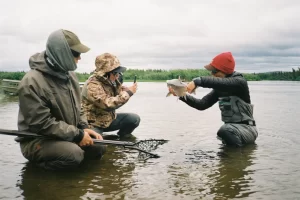Exploring remote Alaska for fly fishing requires thorough preparation and gear suited to the rugged environment. Based on a successful trip to the Last Frontier, here’s a list of nine essentials that can make the difference between an unforgettable adventure and a cold, wet ordeal.
1. Fly Fishing Equipment
Most outfitters provide basic fishing gear, but it’s always a good idea to pack a personal fly rod setup. In Alaska, expect to encounter a range of fish species from rainbow trout to salmon, some weighing over 10 pounds. An 8-weight fly rod is ideal for handling these powerful fish. A sturdy reel with a disc drag system and at least 150 yards of backing is necessary to manage the heavy fish commonly found in Alaska’s rivers. Streamers are the most effective fly choice due to the fish’s preference for salmon eggs and flesh, making floating lines rarely necessary.
2. Waterproof Apparel
Alaska’s climate can be unpredictable, with rain and cold conditions being the norm. Waterproof waders, paired with high-quality wading boots, help keep anglers warm and dry when crossing rivers or wading into streams. A rain jacket with GORE-TEX material is essential to block out water and wind. This kind of outerwear can also accommodate layers underneath, allowing for comfort in varying temperatures.
3. Insulating Layers
Dressing in moisture-wicking, insulating layers is crucial for staying warm. Cotton should be avoided in favor of wool or synthetic materials that retain heat even when wet. Smartwool leggings and tops are excellent base layers, while a lightweight down jacket or synthetic insulated jacket provides extra warmth for colder days.
4. Polarized Sunglasses
Polarized sunglasses are highly recommended for spotting salmon in Alaska’s clear waters. These lenses reduce glare and allow anglers to see beneath the surface, which is particularly useful when targeting fish that swim in schools. Overcast conditions are common, so gray-tinted lenses perform best in Alaska’s often-dim light.

5. Mosquito Repellent
Mosquitoes are relentless in Alaska’s backcountry, especially during the summer months. Bringing a high-strength mosquito repellent is essential to avoid being swarmed by these pests. Many lodges and outfitters recommend packing repellent that contains DEET or other proven insect-repelling compounds.
6. Navigation Tools
In Alaska’s vast wilderness, navigation can be challenging. Bringing a GPS device or smartphone with offline maps is essential, especially when venturing far from familiar areas. A satellite communication device, such as a Garmin inReach, provides added security for emergency situations, allowing users to send SOS messages even when there’s no cell service.
7. Cooking Kit and Extra Food
Although catching fresh fish for shore lunches is a highlight of any fishing trip, it’s wise to pack extra food in case the fish aren’t biting. Lightweight, high-calorie snacks such as trail mix, jerky, and dehydrated meals are perfect for keeping energy levels up throughout the day. A small portable stove can be used to cook fresh fish, adding to the backcountry experience.
8. Camera
The breathtaking beauty of Alaska’s remote fishing destinations deserves to be captured. A durable, waterproof camera is an excellent choice for preserving memories of the trip. GoPros or similar action cameras are ideal for those wanting to record their fishing adventures without worrying about rain or water splashes damaging the equipment.
9. First Aid Kit and Emergency Supplies
Finally, no remote fishing trip is complete without a basic first aid kit and emergency supplies. In Alaska’s wilderness, help may be hours or even days away. Packing a kit with bandages, antiseptics, blister treatment, and medications can be crucial in the event of injury. Emergency supplies such as fire-starting tools, a knife, and an emergency blanket can also be lifesavers if conditions deteriorate.
A remote Alaskan fly fishing adventure promises unparalleled beauty and excitement, but careful preparation is vital. By packing the right gear and essentials, anglers can ensure their trip is both safe and successful, allowing them to focus on what they came for—landing that perfect fish amidst Alaska’s stunning wilderness.
Image/Source: WOS





